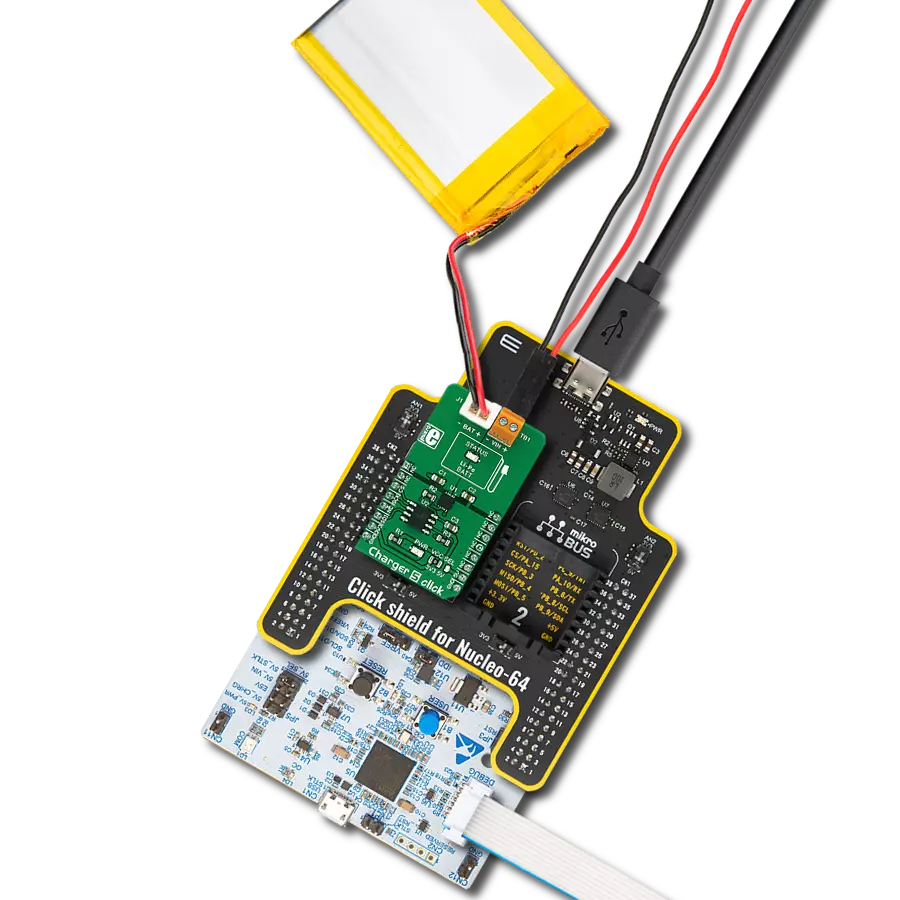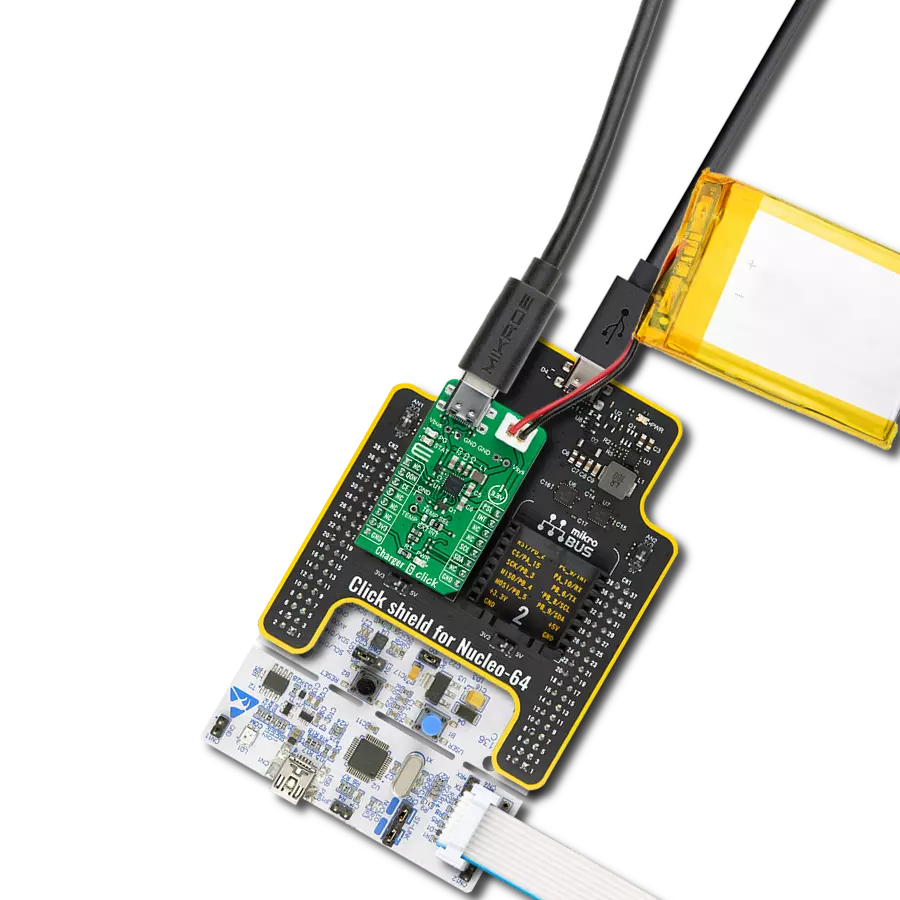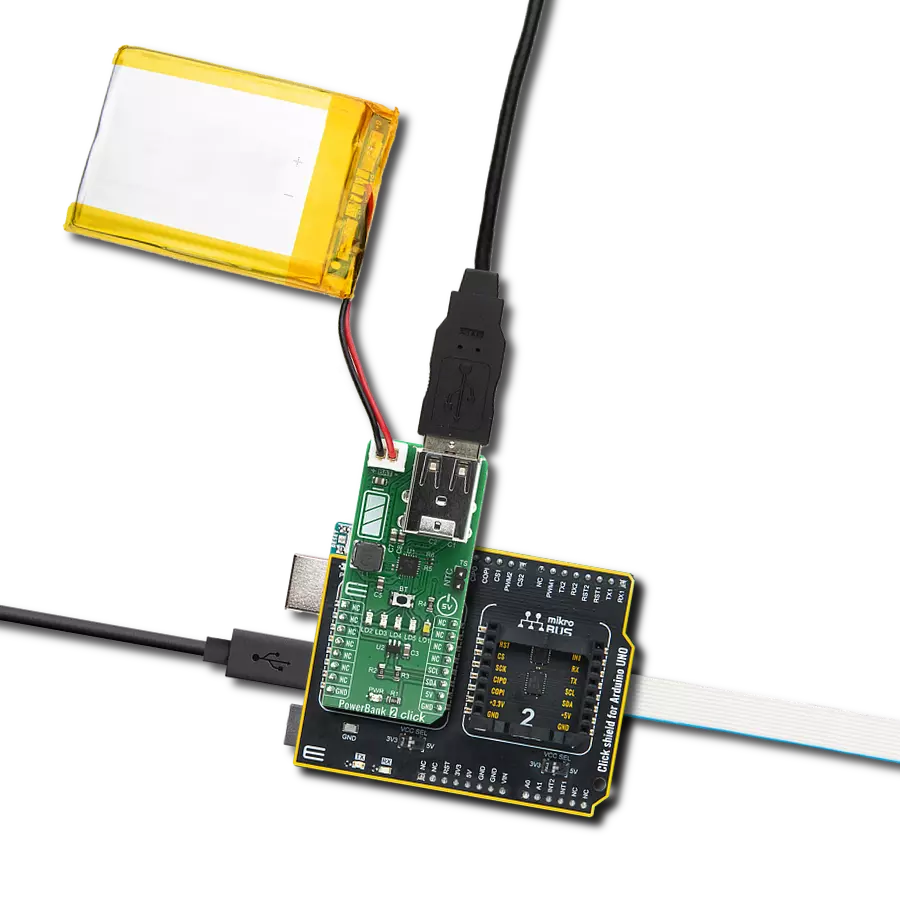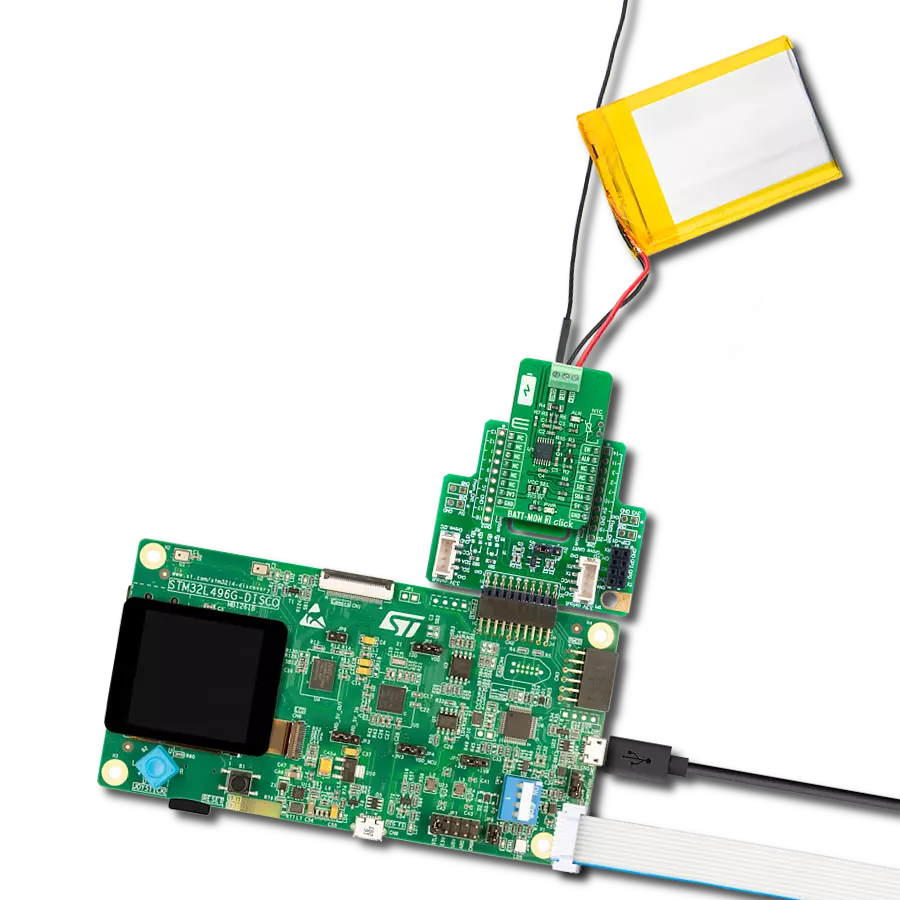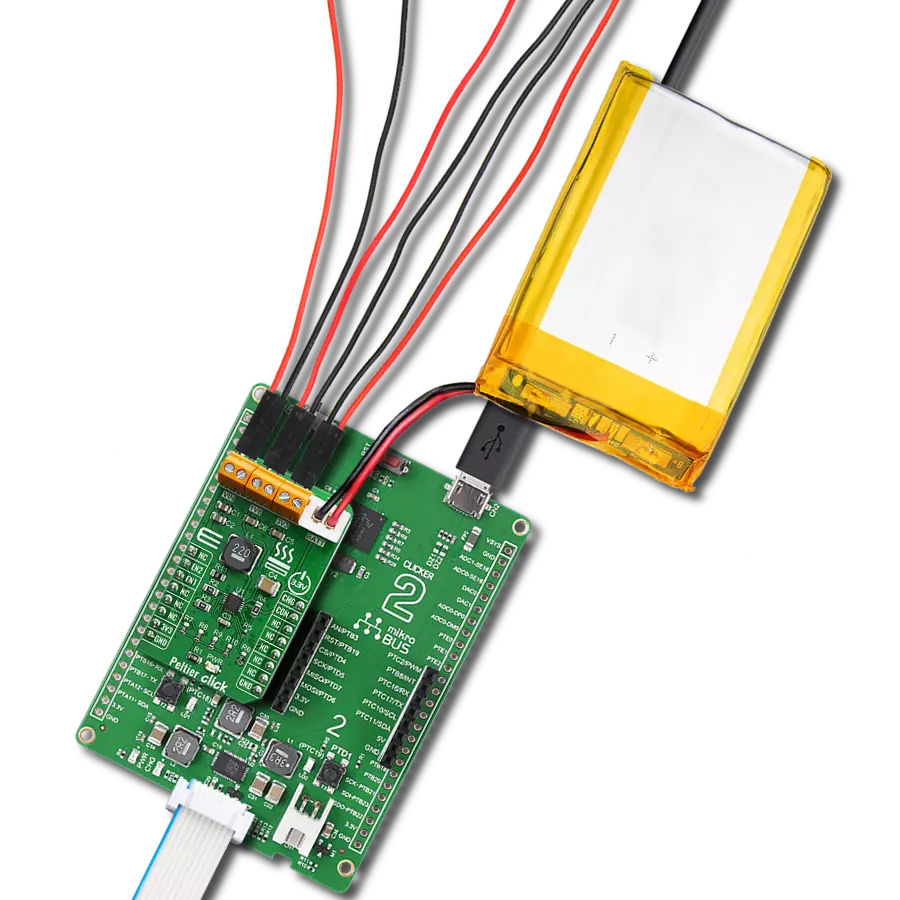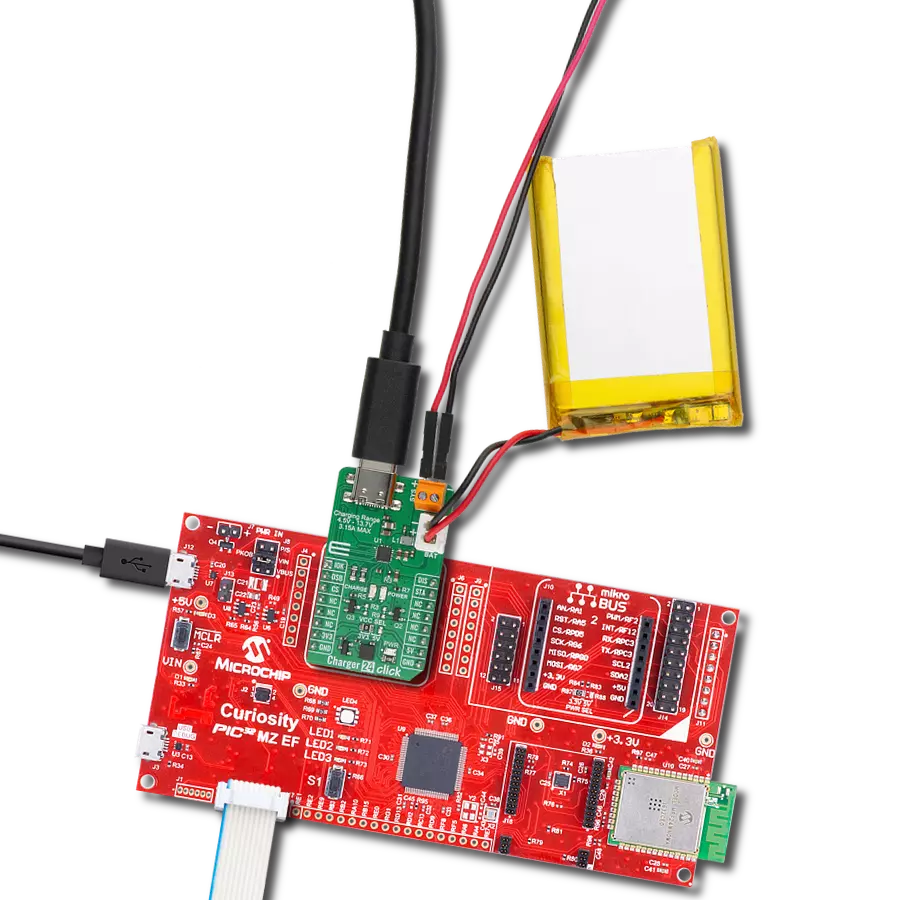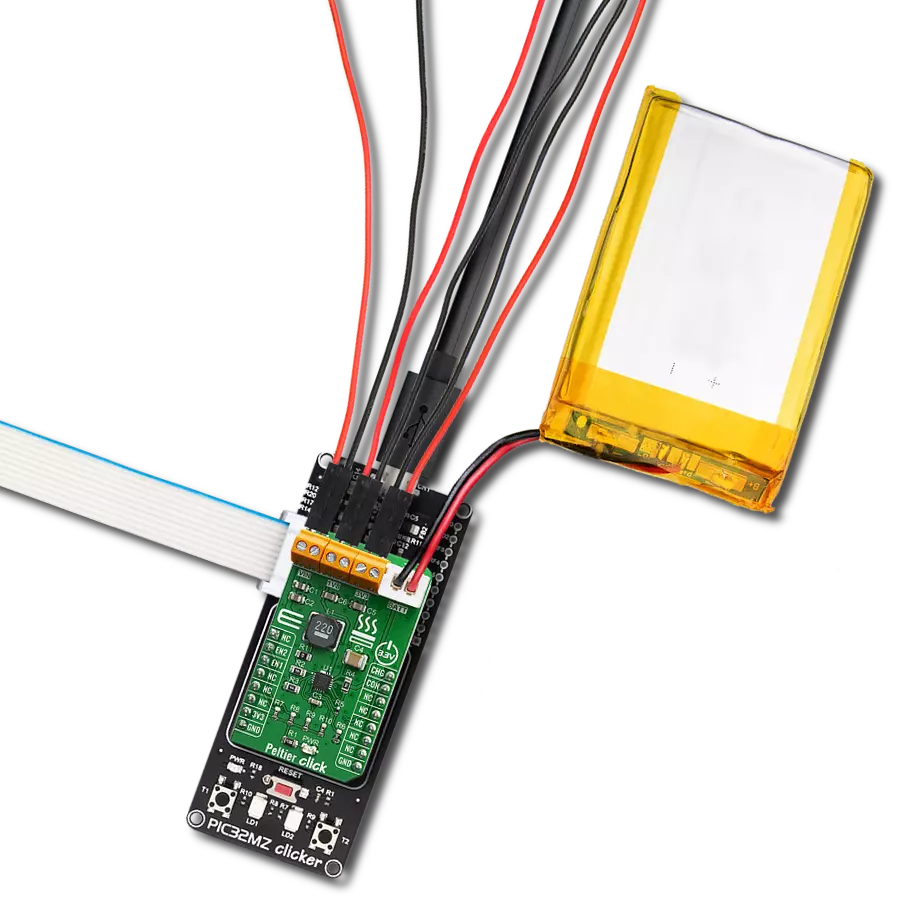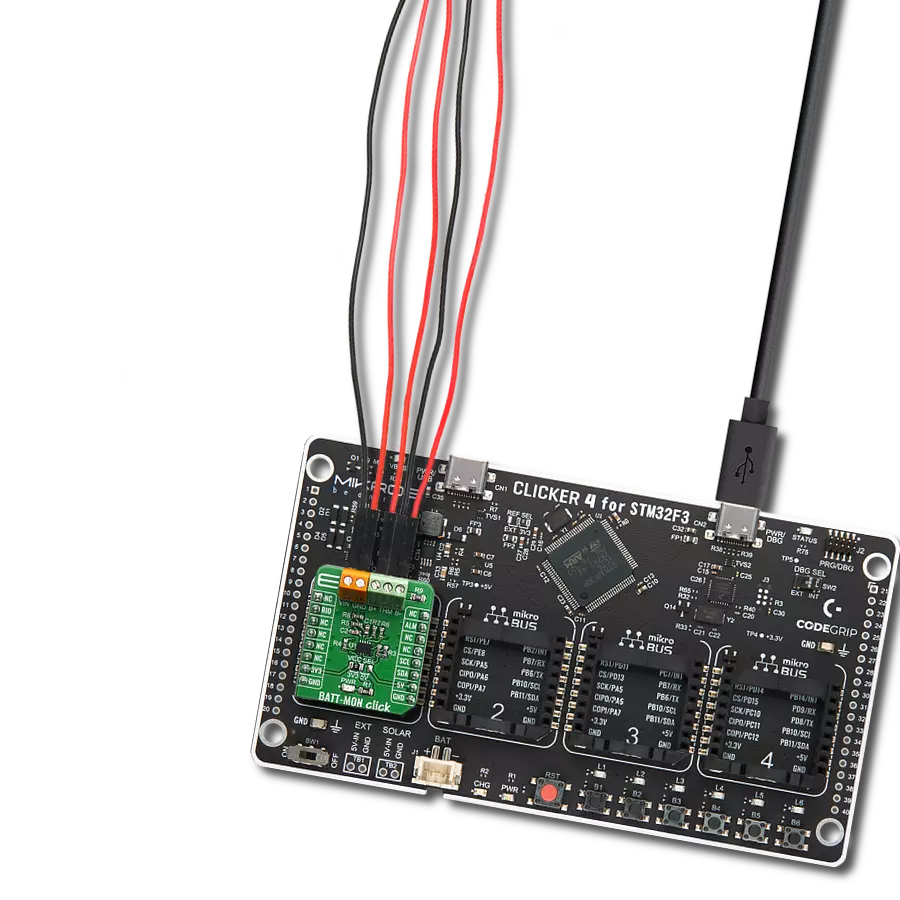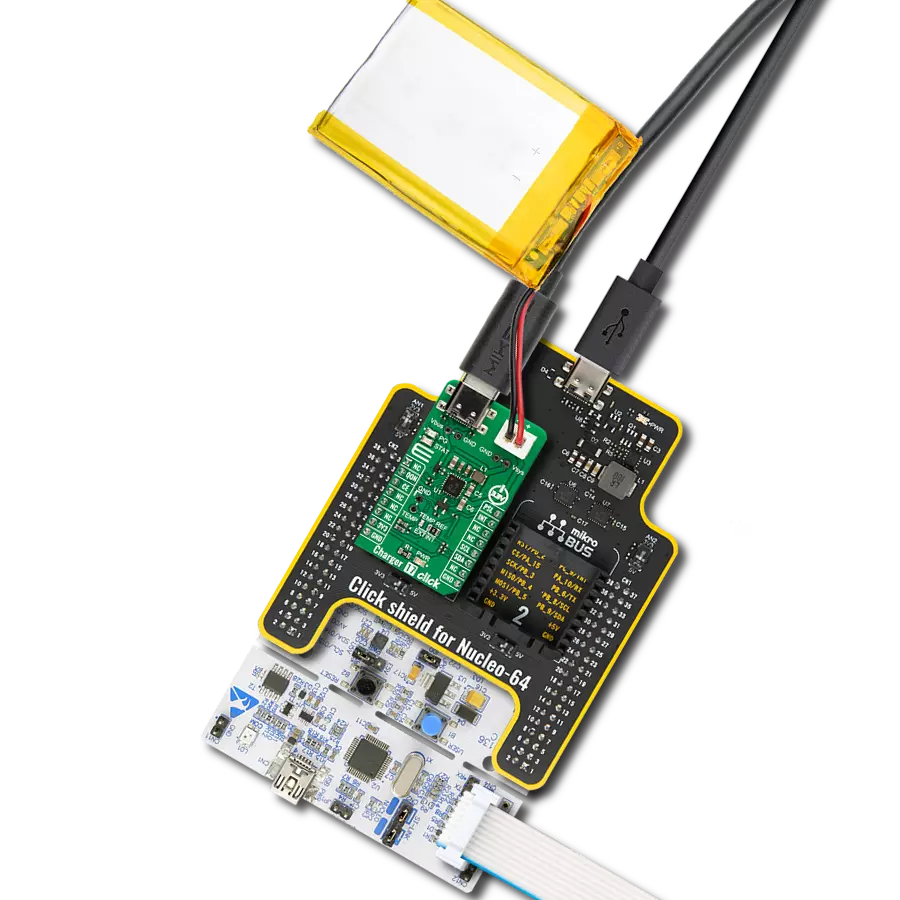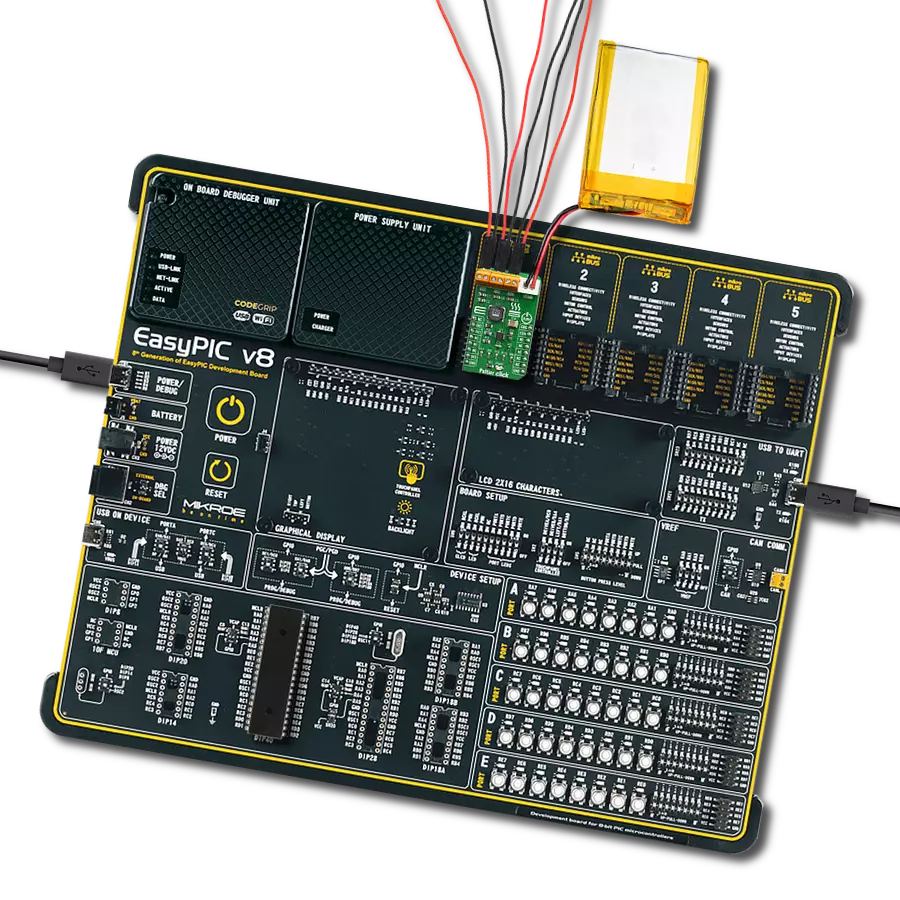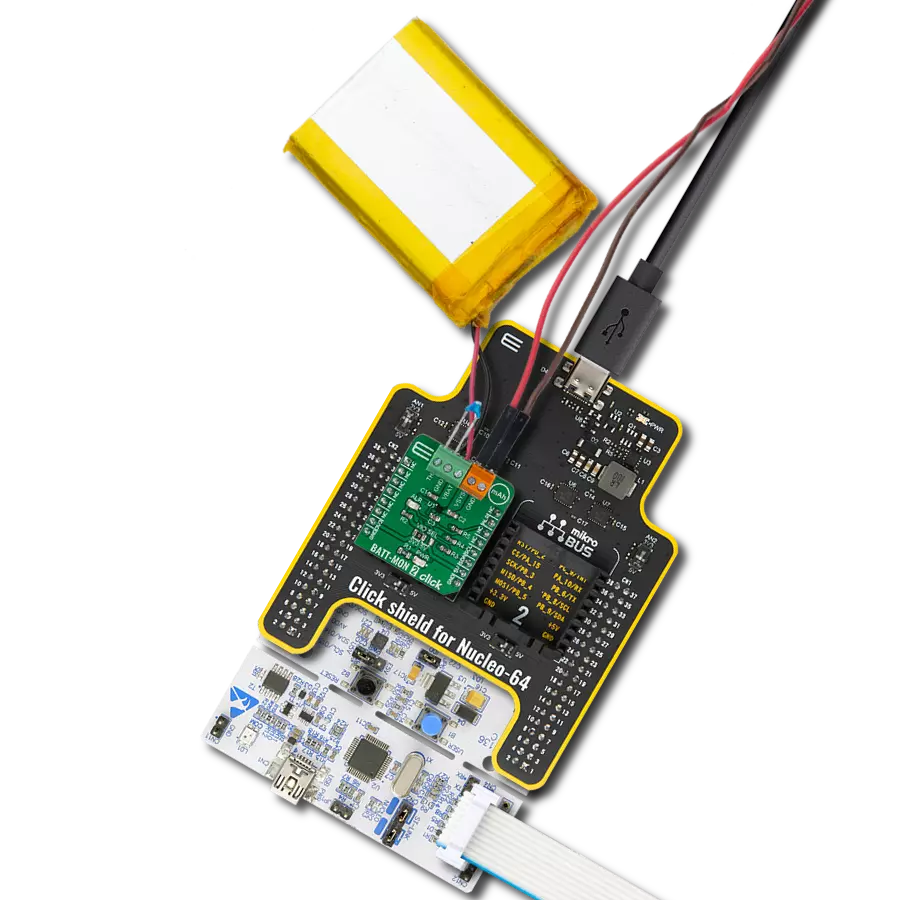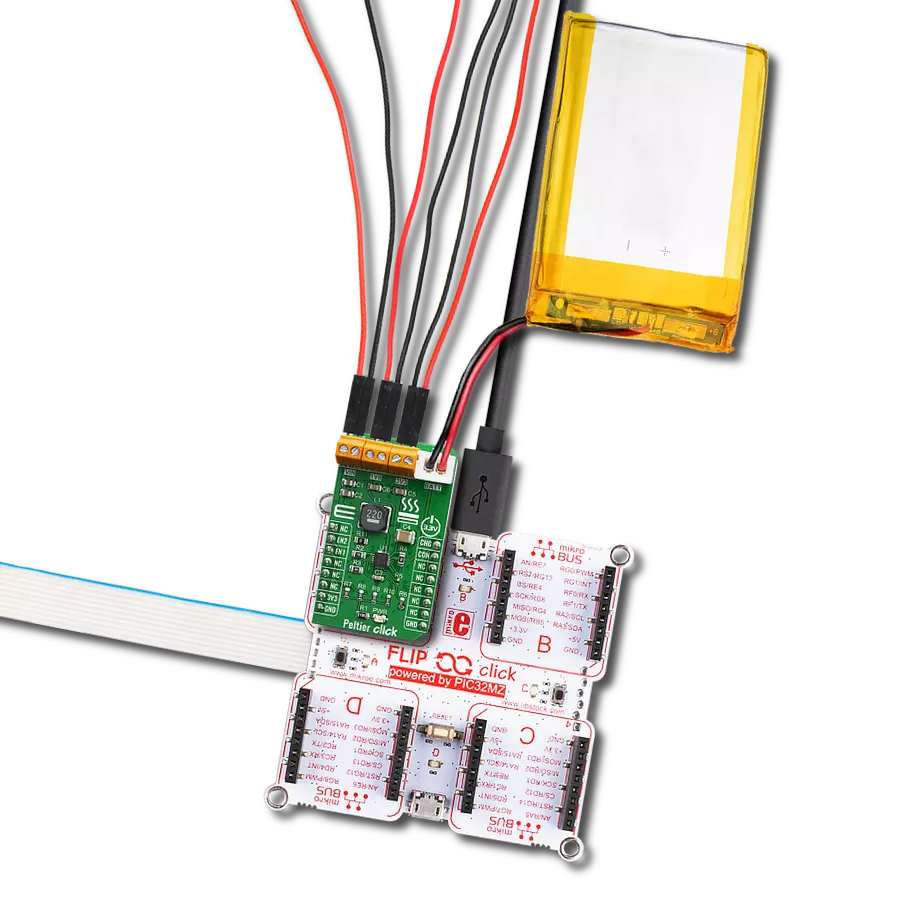Power up your portable devices with an advanced single-cell Li-Ion or Li-Polymer switching charger, designed for a wide input range and on-the-go applications
A
A
Hardware Overview
How does it work?
Charger 27 Click is based on the MP2639B, a Li-Ion or Li-Polymer switching charger from MPS. The charger works in three modes: charge, discharge, and sleep mode. It operates as a switching charger if the input power supply is available. The charger automatically detects the battery voltage and charges the battery in three phases: pre-charge, constant charge, and constant voltage charge. Other features include charge termination and auto-recharge. When the input is absent, the charger can provide a boost voltage to the VIN terminal, the same which is used for the input voltage power supply. This Click board™ uses a
general-purpose I/O to allow the host MCU to control the MP2639B charger. Besides the push button, you can also select charge mode by pulling the MD pin to a LOW logic state and discharge mode by pulling this pin to a HIGH logic state. The charger uses the CHG pin to indicate the host MCU of the charge status and the AOK pin to indicate the valid input supply. There are several LEDs on the Charger 27 Click. LEDs labeled 1 – 4 represent a fuel gauge. The charge completion indicator is available over the CHG LED, and the valid input supply indicator is available over the AOK LED. The discharge function is enabled by pressing the
onboard button for less than 2.5 seconds. If the discharge is enabled, you can turn off this feature by pressing the button longer than 2.5 seconds. You can also set the charge current between 1A and 2A over the ISET SEL jumper. This Click board™ can operate with either 3.3V or 5V logic voltage levels selected via the VCC SEL jumper. This way, both 3.3V and 5V capable MCUs can use the communication lines properly. Also, this Click board™ comes equipped with a library containing easy-to-use functions and an example code that can be used as a reference for further development.
Features overview
Development board
PIC18F57Q43 Curiosity Nano evaluation kit is a cutting-edge hardware platform designed to evaluate microcontrollers within the PIC18-Q43 family. Central to its design is the inclusion of the powerful PIC18F57Q43 microcontroller (MCU), offering advanced functionalities and robust performance. Key features of this evaluation kit include a yellow user LED and a responsive
mechanical user switch, providing seamless interaction and testing. The provision for a 32.768kHz crystal footprint ensures precision timing capabilities. With an onboard debugger boasting a green power and status LED, programming and debugging become intuitive and efficient. Further enhancing its utility is the Virtual serial port (CDC) and a debug GPIO channel (DGI
GPIO), offering extensive connectivity options. Powered via USB, this kit boasts an adjustable target voltage feature facilitated by the MIC5353 LDO regulator, ensuring stable operation with an output voltage ranging from 1.8V to 5.1V, with a maximum output current of 500mA, subject to ambient temperature and voltage constraints.
Microcontroller Overview
MCU Card / MCU
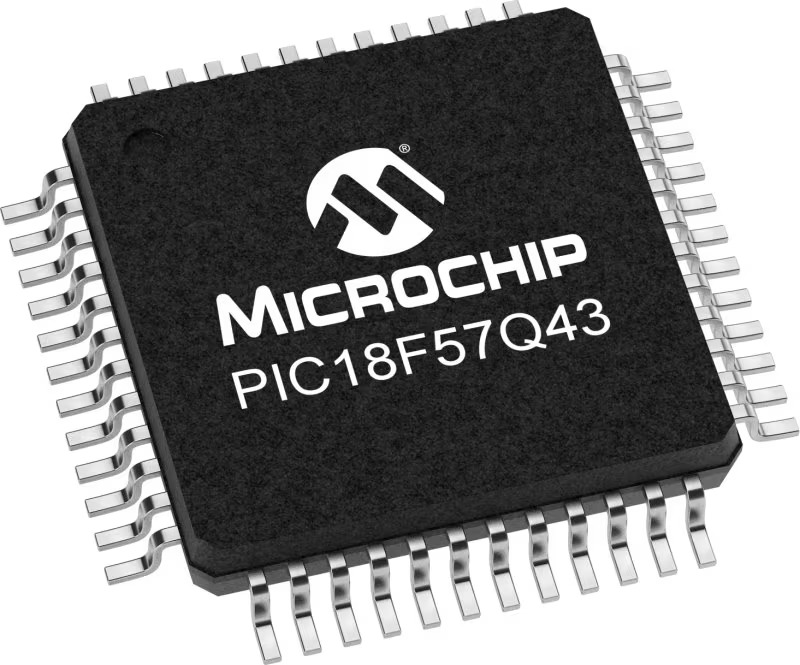
Architecture
PIC
MCU Memory (KB)
128
Silicon Vendor
Microchip
Pin count
48
RAM (Bytes)
8196
You complete me!
Accessories
Curiosity Nano Base for Click boards is a versatile hardware extension platform created to streamline the integration between Curiosity Nano kits and extension boards, tailored explicitly for the mikroBUS™-standardized Click boards and Xplained Pro extension boards. This innovative base board (shield) offers seamless connectivity and expansion possibilities, simplifying experimentation and development. Key features include USB power compatibility from the Curiosity Nano kit, alongside an alternative external power input option for enhanced flexibility. The onboard Li-Ion/LiPo charger and management circuit ensure smooth operation for battery-powered applications, simplifying usage and management. Moreover, the base incorporates a fixed 3.3V PSU dedicated to target and mikroBUS™ power rails, alongside a fixed 5.0V boost converter catering to 5V power rails of mikroBUS™ sockets, providing stable power delivery for various connected devices.
Li-Polymer Battery is the ideal solution for devices that demand a dependable and long-lasting power supply while emphasizing mobility. Its compatibility with mikromedia boards ensures easy integration without additional modifications. With a voltage output of 3.7V, the battery meets the standard requirements of many electronic devices. Additionally, boasting a capacity of 2000mAh, it can store a substantial amount of energy, providing sustained power for extended periods. This feature minimizes the need for frequent recharging or replacement. Overall, the Li-Polymer Battery is a reliable and autonomous power source, ideally suited for devices requiring a stable and enduring energy solution. You can find a more extensive choice of Li-Polymer batteries in our offer.
Used MCU Pins
mikroBUS™ mapper
Take a closer look
Click board™ Schematic

Step by step
Project assembly
Track your results in real time
Application Output
1. Application Output - In Debug mode, the 'Application Output' window enables real-time data monitoring, offering direct insight into execution results. Ensure proper data display by configuring the environment correctly using the provided tutorial.

2. UART Terminal - Use the UART Terminal to monitor data transmission via a USB to UART converter, allowing direct communication between the Click board™ and your development system. Configure the baud rate and other serial settings according to your project's requirements to ensure proper functionality. For step-by-step setup instructions, refer to the provided tutorial.

3. Plot Output - The Plot feature offers a powerful way to visualize real-time sensor data, enabling trend analysis, debugging, and comparison of multiple data points. To set it up correctly, follow the provided tutorial, which includes a step-by-step example of using the Plot feature to display Click board™ readings. To use the Plot feature in your code, use the function: plot(*insert_graph_name*, variable_name);. This is a general format, and it is up to the user to replace 'insert_graph_name' with the actual graph name and 'variable_name' with the parameter to be displayed.

Software Support
Library Description
This library contains API for Charger 27 Click driver.
Key functions:
charger27_set_mode- This function is used for the charge or discharge mode selectioncharger27_check_chg_completion- This function checks the charging completion indicator statecharger27_check_input_supply- This function checks valid input supply indicator state
Open Source
Code example
The complete application code and a ready-to-use project are available through the NECTO Studio Package Manager for direct installation in the NECTO Studio. The application code can also be found on the MIKROE GitHub account.
/*!
* @file main.c
* @brief Charger 27 Click Example.
*
* # Description
* This example demonstrates the use of the Charger 27 Click board
* by enabling charge or discharge mode and
* indicating valid input supply and charging completion.
*
* The demo application is composed of two sections :
*
* ## Application Init
* Initialization of GPIO module and log UART.
* After driver initialization, the app sets charge mode.
*
* ## Application Task
* The Charger 27 Click board operates as a switching charger to charge a 1S battery
* from a wide input power range of 5V to 16V, which can cover a USB PD voltage level.
* The demo application checks and displays the charging completion indicator status.
* Results are being sent to the UART Terminal, where you can track their changes.
*
* @author Nenad Filipovic
*
*/
#include "board.h"
#include "log.h"
#include "charger27.h"
static charger27_t charger27; /**< Charger 27 Click driver object. */
static log_t logger; /**< Logger object. */
void application_init ( void )
{
log_cfg_t log_cfg; /**< Logger config object. */
charger27_cfg_t charger27_cfg; /**< Click config object. */
/**
* Logger initialization.
* Default baud rate: 115200
* Default log level: LOG_LEVEL_DEBUG
* @note If USB_UART_RX and USB_UART_TX
* are defined as HAL_PIN_NC, you will
* need to define them manually for log to work.
* See @b LOG_MAP_USB_UART macro definition for detailed explanation.
*/
LOG_MAP_USB_UART( log_cfg );
log_init( &logger, &log_cfg );
log_info( &logger, " Application Init " );
// Click initialization.
charger27_cfg_setup( &charger27_cfg );
CHARGER27_MAP_MIKROBUS( charger27_cfg, MIKROBUS_1 );
if ( DIGITAL_OUT_UNSUPPORTED_PIN == charger27_init( &charger27, &charger27_cfg ) )
{
log_error( &logger, " Communication init." );
for ( ; ; );
}
if ( CHARGER27_OK == charger27_set_mode( &charger27, CHARGER27_MODE_CHARGE ) )
{
log_printf( &logger, " > Charge mode <\r\n" );
Delay_ms ( 100 );
}
}
void application_task ( void )
{
if ( CHARGER27_CHG_CHARGE == charger27_check_chg_completion( &charger27 ) )
{
log_printf( &logger, " Charging.\r\n" );
Delay_ms ( 1000 );
}
else
{
log_printf( &logger, " Charging has completed or is suspended.\r\n" );
Delay_ms ( 1000 );
}
}
int main ( void )
{
/* Do not remove this line or clock might not be set correctly. */
#ifdef PREINIT_SUPPORTED
preinit();
#endif
application_init( );
for ( ; ; )
{
application_task( );
}
return 0;
}
// ------------------------------------------------------------------------ END
Additional Support
Resources
Category:Battery charger





















